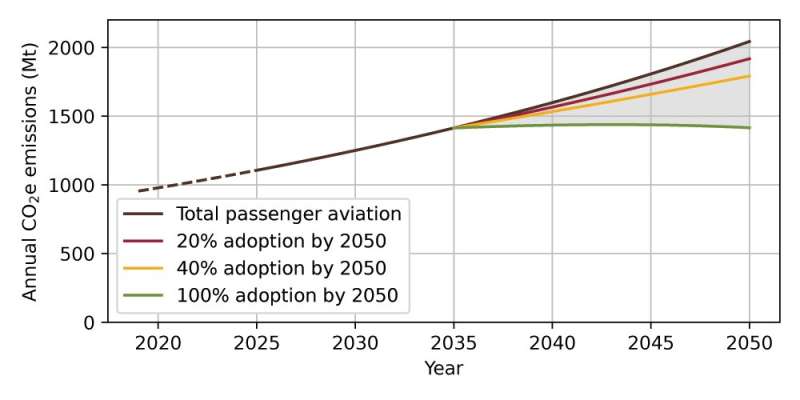CO2e emissions from aviation under various scenarios of adoption of LH2-powered aircraft, 2020 to 2050. Credit: International Council on Clean Transportation
Liquid hydrogen (LH2) combustion aircraft could provide carbon-free air travel on 31%–38% of passenger kilometers flown in 2050, a new study from the International Council on Clean Transportation (ICCT) says. The study examines the performance and CO2 mitigation potential of liquid hydrogen-combustion aircraft that could enter service in 2035. It concludes that aircraft burning "green hydrogen" produced from renewable energy could enable flights up to 3400 km at reduced fuel costs compared to sustainable aviation fuel.
The study comes as European and American regulators are developing mandates and incentives to promote the use of alternative jet fuels.
"Hydrogen-powered aircraft look surprisingly viable from a design perspective," explains Jayant Mukhopadhaya of the ICCT, the lead author of the study. "On the short- to medium-haul flights where hydrogen aircraft are viable, these planes could virtually eliminate carbon emissions." The ICCT study analyzes the performance characteristics, fuel-related costs and emissions, and potential for LH2 aircraft to replace fossil-fuel aircraft.
Two evolutionary LH2 combustion designs based on a standard tube-wing-tail design that could enter service in 2035 were assessed. Each incorporates an elongated fuselage to accommodate LH2 storage behind the passenger cabin. Airbus is evaluating whether to develop LH2-powered aircraft from 2025 under its ZEROe program. Due to the mass and volume of the LH2 fuel tank, these aircraft have a shorter range than fossil-fuel aircraft.
Nevertheless, modeling suggests that evolutionary LH2-powered narrow-body aircraft could transport 165 passengers up to 3,400 km, while LH2-powered turboprop aircraft could transport 70 passengers up to 1,400 km. The study found that evolutionary LH2-powered aircraft could cap, but not absolutely reduce, overall passenger aviation carbon dioxide equivalent (CO2e) emissions compared to 2035 levels.
Capping emissions would require that most short- and medium-haul flights in 2050 be flown with LH2 aircraft using green hydrogen. A less ambitious scenario of 20% to 40% adoption of LH2 aircraft on replaceable routes would mitigate 126 to 251 Mt CO2e in 2050, representing 6% to 12% of passenger aviation's CO2e emissions. Other technologies, including more fuel-efficient aircraft and sustainable aviation fuels, would be needed to meet airlines' aggressive climate goals of net-zero emissions by 2050.
The study also evaluated two hydrogen fuel options and e-kerosene against conventional Jet A fuel. Green hydrogen is expected to cost more than fossil jet fuel but less than blue hydrogen (extracted from fossil fuels, with carbon sequestration) and e-kerosene. Carbon pricing would be needed to make green LH2 cost-competitive with Jet A fuel, with break-even expected at between $100 and $280/ton CO2e in 2050, depending on region.
The study does not address other issues that will help determine the viability of hydrogen as an aviation fuel, including infrastructure requirements and safety concerns surrounding hydrogen delivery, storage, and refueling. Government policies such as carbon pricing, low-carbon fuel standards, or alternative fuel mandates, as well as investments in key hydrogen technologies such as LH2 storage tanks and hydrogen-combustion turbines, will be required to bolster the case for hydrogen-powered aircraft.
"Significant government support will be needed to make hydrogen aircraft work," notes Dan Rutherford, ICCT's aviation director. "But they deserve a level playing field along with 'drop-in' sustainable aviation fuels, which remain scarce and expensive."
More information: Study: theicct.org/wp-content/uploads … hite-paper-A4-v4.pdf
Provided by International Council on Clean Transportation
























